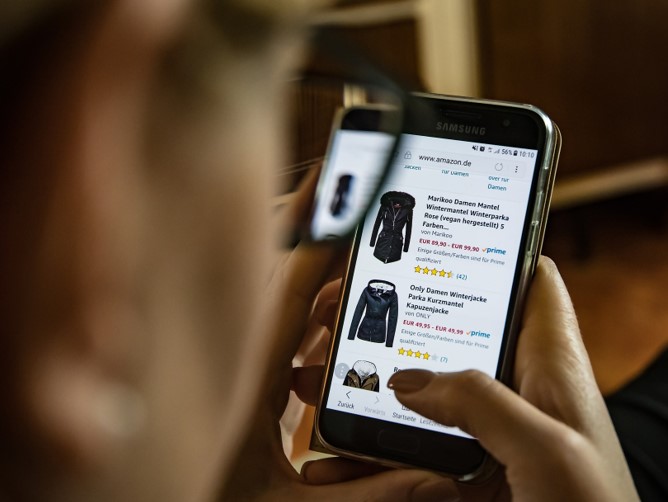What is Mobile Commerce?
Mobile commerce (m-commerce) is when an online transaction, such as a shopping online or transferring money between bank accounts, is done using mobile devices like a smartphone or tablet.
This is different from typical ecommerce transactions that occur on desktop computers and laptop and is slowly transforming the global ecommerce market.
As a result, business owners are adjusting their digital presence to accommodate the rise of mobile commerce transactions, which already produced $400 billion in revenue in 2017 alone. Simply put, any online business that wants to succeed in the future needs to understand the massive future impact of mobile commerce.

In fact, many experts are touting the future of mobile commerce as the new generation of ecommerce.
Types of Mobile Commerce
Looking at the future of mobile commerce requires us to look at the present. Currently, there three main types of mobile commerce, each one playing an important role in the current and future growth of the m-commerce market.
Online Shopping
The most prominent type of mobile commerce is currently online shopping. This is process of buying things online using a smartphone, whether using a dedicated mobile app from a retailer or buying from their website using a mobile web browser.
Because smartphones and tablets have a sleek interface but are simple to use, more mobile users are choosing to use the device for online shopping. For example, 62% of smartphone owners shopped online in the last six months of 2018!
With online shopping being the main driving force behind the rise of m-commerce, businesses are now ensuring that their websites are mobile friendly and/or developing dedicated mobile apps to accommodate consumers.
Mobile Banking
Mobile banking applications have never been more popular and are another key component of the present and future growth of mobile commerce. These apps make it much easier to complete banking transactions online, while it’s also very useful for checking your accounts and managing your finances.
Mobile Transactions
The process of paying for items or services using a mobile device is another type of m-commerce, known as mobile transactions. Instead of using cash or credit cards to pay for something at a store, consumers simply tap their mobile device to the pay point and are charged accordingly.
Applications from companies like PayPal, Android, and Apple have contributed to the increase of mobile transactions in countless retail locations worldwide.
Many believe mobile transactions will revolutionise how we pay for things, possibly leading to credit cards and physical wallets to be replaced with a digital equivalent on mobile devices. Businesses are taking note of mobile commerce too, with countless organisations implemented pay point systems and software’s that facilitate mobile transactions.
The Future of Mobile Commerce
It is safe to say that the future of mobile commerce is very promising. Consumer habits continue to evolve and businesses need to be ready to adjust to these changes or face being left behind.
Mobile Ownership is Skyrocketing
One reason the future of mobile commerce is so promising is the fact that mobile phone ownership has never been higher. For instance, by the end of 2018 it was estimated that there are over 2 billion mobile phone owners in the entire globe. Combined with the fact that 3.2 billion people now have internet access, it becomes apparent that mobile commerce is only set to increase.
Not only that, mobile ownership will also rise, with an estimated 25% increase each year for the next five years. More mobile phones and more with internet access means more mobile commerce transactions than ever!
Mobile Browsing is Becoming More Popular than Desktop Browsing
When comparing the online browsing habits of people that own both desktop computers and mobile devices, most users spend on average double the amount of time on their mobile. For example, the average time browsing on a mobile device is 87 hours per month – more than half the 34 hours spent browsing on a desktop computer.
As mobile ownership continues to rise, so will mobile browsing, directly influencing the volume of m-commerce transactions, so businesses need to make sure they are prepared for this!
Mobile Commerce Sales Rising Each Year
Mobile commerce sales already account for 34% of all ecommerce sales according to mobile boosters, with the figure guaranteed to rise over the next few years, which is impressive considering over one third already occur on mobile devices!
In terms of future growth, it’s believed that more than half of all ecommerce (54%) transactions will be on mobile devices by 2021. When billions of dollars’ worth of online transactions are happening on mobile devices, ecommerce platforms need to make sure they are mobile-friendly to take advantage of this massive market share.
For instance, ecommerce sales this year are expected to hit $3.418 trillion, meaning mobile commerce sales could account for over $1 trillion.
As Mobile Commerce Grows Our Shopping Habits Evolve
Being able to easily check online stores for information on a mobile device is already influencing our shopping present day shopping habits at physical retail locations.
For instance, around one third of buying decisions are directly influenced by a mobile device, typically by using their phone for more information before purchasing something.
With an increase in smartphone ownership over the next few years, more shoppers are going to use their mobile device to help their decision making. This could be checking reviews, price comparisons, or more product information, with around 80% of shoppers using their phone when inside a physical store.
This could very well influence how physical retail stores are designed and developed. If people are using mobile devices for shopping decisions, retailers may consider installing mobile devices or providing Wi-Fi instore.
Mobile Commerce Revenue is Already in the Billions
The past also gives us some insight into the future of mobile commerce and where it could be headed.
For example, mobile commerce hit $700 billion in revenue in 2017 alone, which was a 300% increase over the previous four years, highlighting how mobile commerce is growing at breakneck speed with no signs of slowing down.



































